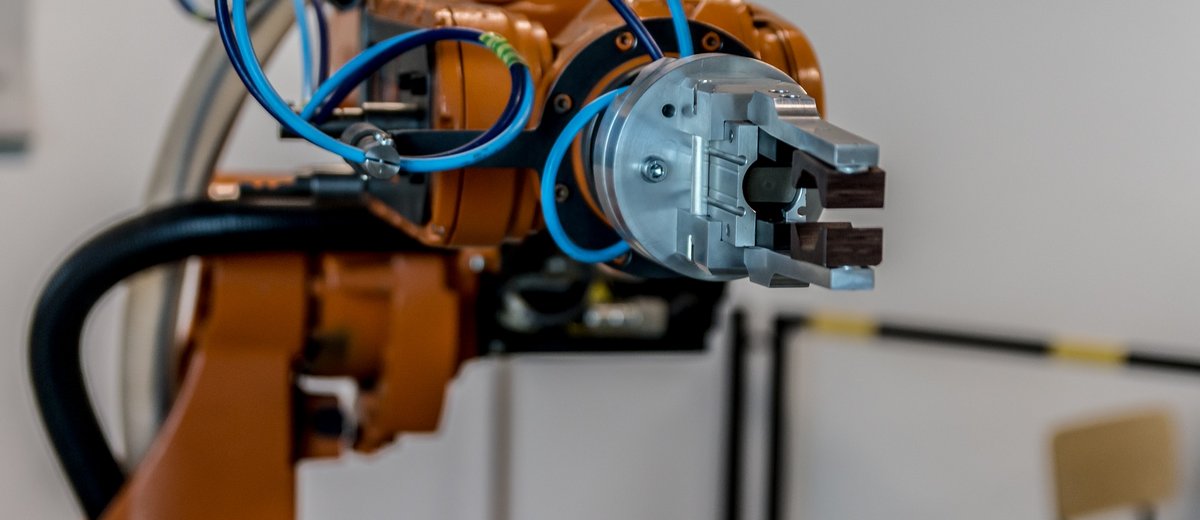
Industrial robots that work together with humans in a direct and protected environment are referred to as collaborative robots, or cobots. This means that the use of protection devices is not required. In this context, it is essential that the robots in question are able to function reliably and do not represent a danger to humans. The concept of collaborating robots originates from a research project conducted in 1995, the objective of which was to enable hand-in-hand cooperation between robots and people. Following the project’s realisation, cobots began to appear in the assembly halls of a variety of production facilities. The differences between cobots and the more familiar class of robots, however, remain unclear to the majority of people. Even so, cobots today are of major relevance and they are constantly evolving and being enriched through new and innovative technologies.
Robots have established themselves over a period of many years in the industrial sector and are now even being used more and more frequently in domestic applications. Robots for domestic use generally either perform useful jobs or serve entertainment purposes. Successful cobot implementations include autonomous lawn mowers and vacuum cleaners. Robots are used in industry in situations in which they are able to perform tasks automatically and largely without any human intervention. Industrial robots can be contrasted with collaborative robots. While conventional robots can generally be said not to interact with people and are spatially separated from them, cobots are designed to work hand-in-hand with humans. Cobots are equipped with sensors and they are programmed such that they are able to switch themselves off in the event of coming into contact with an obstacle. This prevents them causing any harm to nearby persons. Moreover, sensors and cameras are employed for the purpose of object detection and recognition; this enables the system to distinguish, for instance, between a work object and a human limb.
The first generation of collaborative robots was incapable of independent motion. Humans provided the required movement, which they performed together with the cobot. Newer types of robots were capable of regulating movements and altering their direction of motion. Subsequent generations became capable of performing movements automatically or under their own control. In contrast to many industrial robots, cobots are able to adapt their tempos to the working speeds of humans, although theoretically they would actually be capable of faster movements. However, the prime consideration is the safety of the worker. Cobots are used, for example, in jobs involving screws or materials that may be hazardous to humans. To ensure the safety of humans, stringent requirements are placed on the technical and mechanical components of the devices. A drive suitable for this type of functionality is available from Harmonic Drive AG in the form of the CanisDrive® series, with a central hollow shaft and a tilt-resistant output bearing; the solution is not only precise but also enormously compact.
The object of deploying cobots is not to fully replace humans or to oust them from their jobs. Rather, the aim is for collaborative robots to assist people in performing complex tasks, which means they are not working for, but with, people. The human, or more precisely, the worker, generally performs jobs that are finer in nature than those that a cobot is capable of performing. A cobot can be used, for instance to pass components to an employee, who then performs some kind of precision activity. Industrial robots, on the other hand, are commonly machines that are able to operate quickly and powerfully, without any consideration for their environment, exclusively performing preprogrammed work sequences. Industrial robots are generally enclosed in cages or installed in isolated rooms so as not to endanger human workers.
As a rule, collaborative robots are easy to programme and can learn new aspects independently, unlike classic industrial robots, which require specialised programming techniques and knowledge. Many cobot models are able to imitate movements and reproduce them when required. The devices’ ease of programming is based, moreover, on the use of simple user interfaces. There are models in use that can be operated and reprogrammed using a graphic user interface.
Thanks to their mobility and ease of programming, cobots can be flexibly employed within the production chain and are not bound to a certain position. In the event that the production hall undergoes restructuring, no appreciable costs are incurred for dismantling or reassembling complex machinery. The devices can be attached to the ceiling or floor and used vertically or horizontally. The use of light components ensure the cobots’ agility.
It is undisputed that cobots will play a key role in future projects such as Industry 4.0, the goal of which is to comprehensively digitalise industrial production in Germany. To this end, cobots are not merely regarded as forward-looking production components designed to make employees’ work activities more bearable but are also able to simplify and optimise the collection of company-internal data. This data is responsible for the efficient and effective evolution of production activities.
The safety aspect of cobots plays a major role in their continued development. For this purpose, cobots are currently equipped with, among other things, force sensors, capacitive sensors and numerous photographic sensor systems, which collect information in real time and feed it to a computer programme. If the software detects a fault or a risk, it must be able to halt the device’s operation with immediate effect.